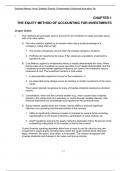Exam (elaborations)
Solutions for Fundamentals of Advanced Accounting, 9th Edition by Hoyle
- Course
- Institution
Complete Solutions Manual for Fundamentals of Advanced Accounting, 9th Edition 9e by Joe Ben Hoyle, Thomas Schaefer and Timothy Doupnik. ISBN 0447 Full Chapters Solutions Manual Chapter 1-12 Chapter 1: The Equity Method of Accounting for Investments Chapter 2: Consolidation of Financial...
[Show more]



